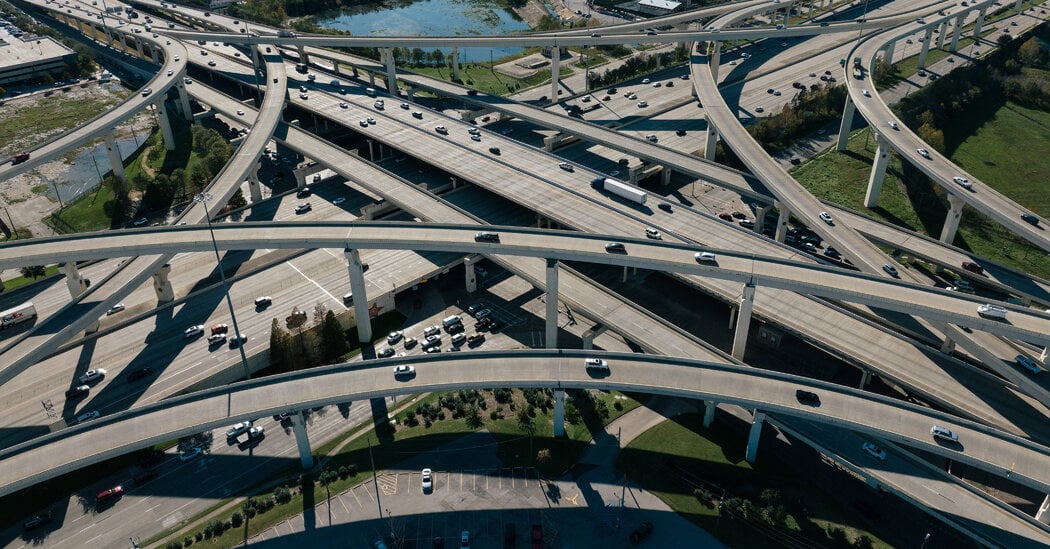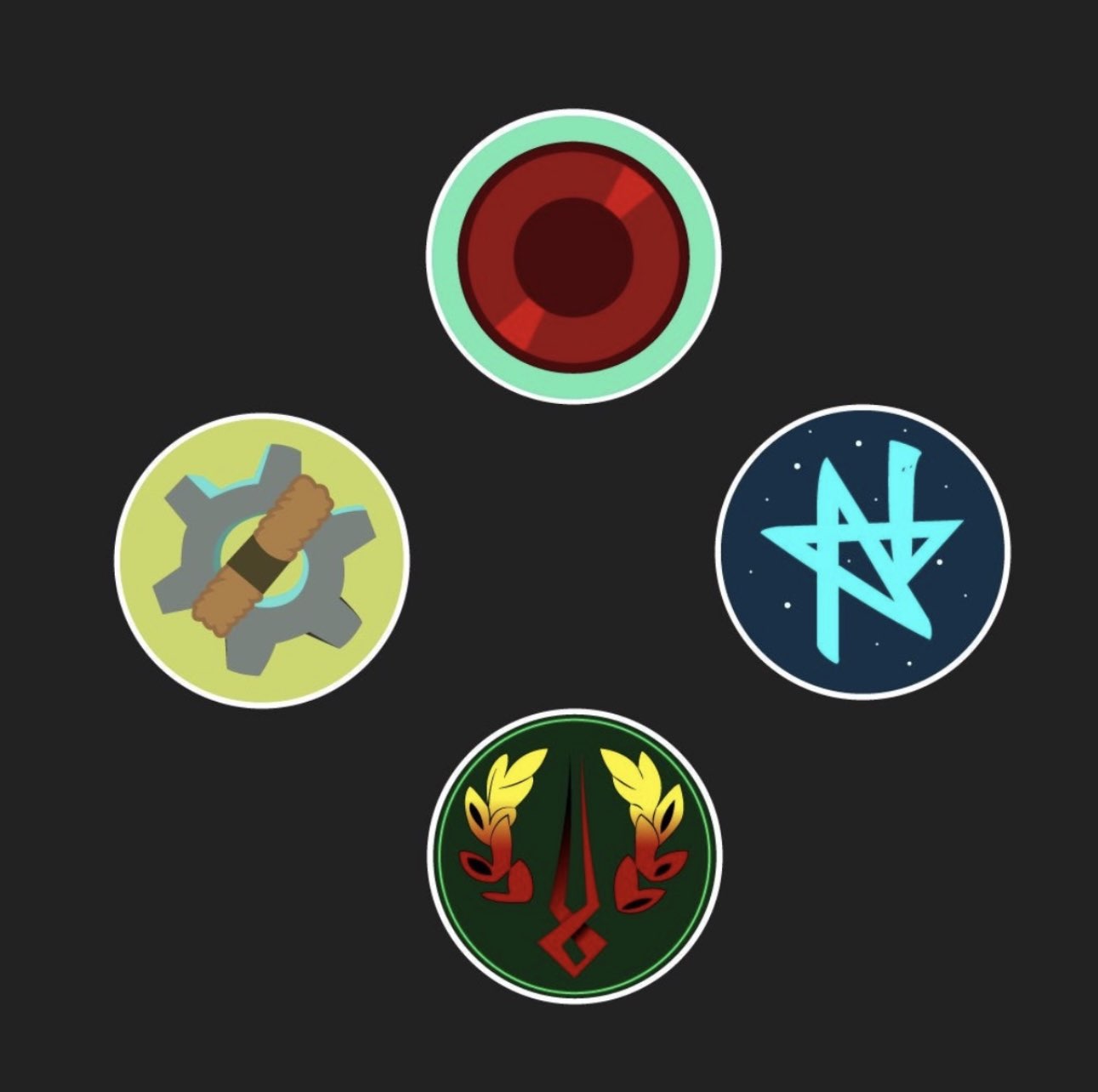For critics of widening projects, the prime example of induced demand is the Katy Freeway in Houston, one of the widest highways in the world with 26 lanes.
Immediately after Katy’s last expansion, in 2008, the project was hailed as a success. But within five years, peak hour travel times on the freeway were longer than before the expansion.
Matt Turner, an economics professor at Brown University and co-author of the 2009 study on congestion, said adding lanes is a fine solution if the goal is to get more cars on the road. But most highway expansion projects, including those in progress in Texas, cite reducing traffic as a primary goal.
“If you keep adding lanes because you want to reduce traffic congestion, you have to be really determined not to learn from history,” Dr. Turner said.
Just one more lane bro, I swear it’ll fix traffic. Just one more lane.
Just a little more trickle down bro, I promise once we privatize the next utility it will all work.
Lol. One thing I just thought of. Ignoring the extremely obvious fact that trickle down economics is something you tell stupid people to be okay with getting the shaft… can we name one time in history (golden shower jokes aside) where something trickling onto you is a good thing? The word carries questionable connotations. I don’t want anything trickling onto me…
snorts asphalt
Underrated comment of the day 🤣
The intended purpose isn’t to fix traffic. It’s supposed to allow more volume of cars through per day. Entirely different things.
I’m not suggesting that’s a good thing.
deleted by creator
Eventually there’s gotta be diminishing returns too given that every lane makes it a little harder to drive on. Can’t imagine the idiots swerving over 13 lanes of traffic because they didn’t realize they had to get off until the last minute
T R A I N S
Here is an alternative Piped link(s): https://piped.video/0dKrUE_O0VE
Piped is a privacy-respecting open-source alternative frontend to YouTube.
I’m open-source, check me out at GitHub.
Yup. Been plenty of studies to show that increasing lanes only alleviates traffic in the short term and long term only makes it worse. Better to spend money on trains and busses that actually work and get people where they need to go with minimal hassle and a reasonable cost than to do this crap.
to me it’s like the military industrial complex - they don’t care what evidence supports, they want their fucking money and they’ll keep building roads until it’s a giant parking lot from sea to fucking sea. we could have an ecosystem, but fuck you, because cars.
I already see the angry republicans on Fox news raging on how their precious tax dollars are being wasted just to benefit poor people
Yeah it’s too bad only poor people can ride trains :(
It also costs the taxpayer more because of maintenance
I don’t necessarily disagree that it costs more, I have no idea but it seems logical to me that it would. However, even if it is cheaper, public transit solutions also have maintenance.
Far less maintenance, and it’s generally directly supported by rider fares instead of petitioning for government tax money.
Also the density of passengers on transit justifies the costs. 90%+ of all cars have a single person, whereas transit is on average magnitudes more. On that basis alone transit is far far cheaper.
and it’s generally directly supported by rider fares instead of petitioning for government tax money.
Fares alone do not pay the bills. Buses are always subsidized (which is totally fine IMO. Every fine metro area has a good transit system, and it should be affordable to all who would want to use it.)
True enough. But my point still stands that there are fares that are collected that help offset operational and maintenance costs.
It’s still cheaper than maintaining huge roadways.
trains and busses that actually work and get people where they need to go with minimal hassle and a reasonable cost
Trains predate cars and busses have always been with us since the car. People have voted – with their cars.
The Interstate Highway System started in the 1950s. Population has more than doubled since then. Of course, we have more traffic, we have more people!
The auto industry lobbied to kill public transportation back in the day to sell more cars. For a recent example see Ellen Musk and the Hyper Loop.
deleted by creator
History? Is that a recent thing?
Source: live in Texas :(
History is a conspiracy cooked up by cultural Marxists to push their gay liberal agenda
Remember the Alamo? It’s like that but the stuff that happened after, up until now. I don’t know if there was anything before.
Source: I paid attention during my Texas History classes. (It’s an actual required class in Texas, at least when I went)
They got rid of everything before the Alamo. They towed it out of the environment.
This is because the extra lane allows demand to change. It is not congested so people feel ok building and moving to further out suburbs. This continues until demand has increased to cause delays.
Note that Houston and Paris have about the same population. Paris is 1/3 the size. They are actually removing a lane from their loop highway and planting trees, and turning another lane into busses only. Only considering transportation, I would much rather live in Paris.
If you also consider the weather and politics, I would still much rather live in Paris.
Food and culture, also Paris
Houston has fantastic food. I will die on that hill.
I know I’m putting myself in harm’s way, but I would say Austin instead. Houston is a large parking lot with buildings in-between.
Austin is not a better food city. It might be a better city, but not because of the food.
I was just being facetious; I spent quite some time in Plano and around Dallas and I don’t miss it due the whole commuting thing.
I had to drive to Houston now and then it was a miserable experience, and made me bitter of the whole Americana road trip thing.That said, on last trip, we went somewhere down to Sant Jacinto (?) and I’ll gladly live there. I did had some delicious crawfish that later vomited somewhere along the I-10 East freeway.
Edit: maybe I’m just mad nobody wears ten gallon hats.
I’ll die on that hill with you. Most likely from self-induced health problems from loving the good food here too much, but for all the crap that we deal with the good food is a plus.
Let’s list the reasons why Houston is better…hrmmm…I got nothing.
Less French people?
Plenty of Cajuns in the area, which is basically French-Swamp-People
We prefer swamp frenchies.
Source, am half swamp frenchie
French bad. Wow, never heard that one before.
But what options do you have in Houston, compared to Paris?
You can’t just not widen roads but instead
— less sprawl - places to live closer to each other and to destinations
– useful transit or short distance commute options
– remove bottlenecks
These are a lot harder to do, and I don’t imagine Houston even considered it
Investing is public transport can be as hard or as easy as you want it to be. Sure building a full on subterranean high density metro system might be the utopia, but actually developing a high frequency, high quality bus route with dedicated bus lanes can be low cost and hugely increase the volume of people carried Vs the lane you took from cars.
Compliment this with docking cycle rental schemes, and some dedicated cycle infrastructure and you can transform how a big chunk of people get to work …you start to win back the city from one which is built around cars and instead making it a city for people.In Texas, and most of the places I know of, people won’t ride the bus, or the bike. When it’s August and the high temp for the day is 108, with 65% relative humidity, everybody wants to get in their car with the AC blowing directly on them, and be comfortable.
In my experience, every public bus I’ve been on has been miserable.
Paris also has a subway.
A modern bus on a hot day is like walking into a fridge in my country. They also look about 30 years newer than whatever I’ve seen when it comes to American buses, so that might help a little.
I stayed in Paris for a few months once, never once used a car. Never once had a problem getting somewhere, either.
This makes sense. With the increased cost of city living, and an ever increasing population; doesnt this support the need for more lanes?
Why, oh why didn’t they build 27 lanes?!?
99% of urban planners stop just one lane short of permanently solving traffic for good.
Simply make it a single flat wide open surface, drive where you’re trying to go in a straight line.
If you die, you die.
Well the population decrease would certainly decrease traffic so I think you’re on to something.
Sounds like Moscow
Otherwise called, the Mad Max method.
Yes. This is the basic driving style on the Katy. No rules, no lanes. Just wide open spaces, bumper to bumper at a minimum of 75 mph. On a good day.
I live in Katy. Driving through this from 4-7 pm is an absolute nightmare. Horrible traffic jams, erratic drivers and multi-car accidents daily. Mornings aren’t fun either.
After Hurricane Katrina I lived in Houston for about six months. I still have nightmares about your highways. I don’t know how y’all do it.
Oh jeeze… it was so bad after Katrina. I’m sorry you had to deal with this and the hurricane.
Toll roads were a great alternative 10-15 years ago. Now they are just as bad as freeways. It’s nearly impossible to find alternatives unless Google Maps finds a neat back way around this hell hole.
Luckily I was a typical self-centered teenager, so I was pretty good at being oblivious and ignoring what was going on around me. It also helped that I had very strong parents who worked tirelessly to make it as seamless/normal for my siblings and me haha.
Well hopefully they will come up with a solution that isn’t just adding more lanes! Don’t have a lot of hope for Texas and public transit these days, but I feel like y’all would be prime candidates for high speed rail between some of your cities.
Sounds like you have amazing parents!
And yeah, a speed train would be great, but I doubt we’ll ever get one. I was very excited for the infrastructure plan, but who knows if and when it’ll happen.
deleted by creator
Oh absolutely. A few years ago someone did just that because they were about to miss their exit. I slammed on my breaks and it caused 8 cars to crash. I wasn’t found at fault, but because I was the first car to stop, I had to deal with 8 different insurances from all the people involved… it was such a pain. The whole thing took around 4 months to settle all the claims and get my car fixed.
Who knew that adding complexity to a system entirely reliant on millions of autonomous drivers who only communicate with each other through lights, horns, and middle fingers would slow things down.
Lived out there for a few years and i can tell you no one is communicating through the lights on their cars.
Maybe flashing the brights
That might get you shot in Texas. It’s a low bar there.
Similar in Southern AZ, but that didn’t stop people!
Perhaps drivers who can’t understand the “complexity” of highways shouldn’t be on the road.
Exactly, it’d be great if said drivers had some compelling alternative to get around.
You, one of those autonomous drivers, going from point A to point B might not be that complex. Traffic management in a system with millions of drivers is obviously very complex.
Proud to not understand that systems can be varying degrees of complexity? Not really something to be proud of.
There are limits on how well you can train a dry nosed monkey to drive a car.
That’s not the gotcha you think it is.
Dunning–Kruger effect on display.
For anyone wondering what that looks like-

Absolute insanity.
Where are the bridges? How do you walk from one side to the other?
Oh yeah, right, of course. But how do you even drive from one side to the other?
You don’t really… You exit and follow the service road until you find a way to get across, usually by going under.
I hate driving in Texas because this kind of shit is everywhere. Middle of nowhere and want to get to the rest area ahead? Exit and follow the service road for a mile.
I feel like Texas intentionally did that so that everything seems large af. If the exit road is long af then it must make you feel like the place is large when in reality it is just inefficient spaghetti
It’s not an exit road. The service road is a parallel road to a highway that contains all the turns with occasional on/off ramps into the highway. It’s actually a pretty efficient design, as it reduces the amount of on/off ramps needed. Similar design style is local vs express lanes in some highways.
Tl;dr less ramps = less slowdowns
I have no idea. I’ve never driven on it. I was just searching around and was mortified.
Walk? In Houston? Nope.
Hey this looks just like my failed Cities Skylines build!
The fools, if they had made in 27 lanes they would have been fine!
27 is an odd number, do I assume the center lane switches direction for rush hour. That’s sure to fix it.
27 lanes in each direction.
I thought it was common knowledge of the only way to reduce traffic is to reduce demand on roads, eg more expensive gas and tolls etc.
If you add another lane to the highway you’re just gonna attract more people and make it worse.
deleted by creator
I agree. In addition to impacting the poor in towns and cities, raising gas prices also has an even larger impact on people in more rural areas where everything is spread out. We do most of our grocery shopping in the next town over, which is 15 miles away, with basically nothing in between. Sure it still takes only 15-20 minutes to get anywhere we want to go, but those minutes are a lot more miles out here compared to driving 15-20 minutes to go a shorter distance I’m a city.
Within towns and cities, infrastructure should be built for people first, not cars, so as to make it easier and more pleasant to navigate a city by foot, bike, or public transit. It drives me crazy how pedestrian hostile most towns are. I’d like to see the design paradigm flipped.
Reducing traffic by raising prices is a pretty piss-poor way to do so if the only alternative is walking or decrepit bus lines. There need to be other measures taken.
You mean by… Fixing the bus lines and adding more public transit?
Yep. But that has to be done first. The Houston metro has piss poor public transit. Honestly most of the south does.
The US is all about more lanes for cars and less public transportation. Congestion be damned. Because “SoCiaLiSm.”
Funny thing is that congestion is basically queuing for mobility services. And queuing is exactly what you get in communist systems where the state provides for you. So highways are socialism!
deleted by creator
#3 Americans are too selfish to zipper. The proper American solution is to install special traffic lights mounted with cameras that fine whoever does not zipper on the right time
Yeah, traffic congestion is a lot more complex than it seems. If you alleviate one bottleneck, you can create 15 more (because now more traffic flows through the “fixed” area, stressing everything else) where some of those new ones interact with each other in a way that slows traffic more than the original bottleneck did.
You need to consider the endpoints as well as the middle. If you make it easier for people to get to their destination and off the road, then traffic will improve. Problem is, destinations are all over the place, so even that can end up causing more congestion if it also enables higher throughput that other roads it feeds into can’t handle.
Mass transit experiences the same thing. Not to say that there’s no point in emphasizing it, just that it won’t get rid of the problem entirely.
deleted by creator
You can reduce traffic with more lanes, but not just willy nilly. They need to be carefully planned and managed while limiting lane changes.
But a lot of the time, they won’t. The issue usually comes from people wanting to change lanes while others are merging on. In high traffic areas, lane changes will slow the traffic down while increasing the risk of an accident. Making alternatives such as different routes, other modes of transportation, or reducing the need for traveling usually work better in cities.
By that logic just make driving illegal, problem solved!
Something is left out of the equation because more lanes != more traffic, yet there is ALWAYS someone around saying otherwise. Go drive on the highways in Montana if you don’t believe me.
Houston is commonly used as an example for what NOT to do, when it comes to civil planning and development.
Consider adding gift links to this community: https://sopuli.xyz/post/2743454
Literally play 2 minutes of cities skylines and you will discover how bad of an idea this is lmao
I say the words “shitty skylines” way too often driving around the real world. My city lives and dies on suicide lanes >_>
If you’ve got more lanes then you’ve got more lanes for idiots to cross right before the exit they need to take because they weren’t paying attention and they MUST take this particular exit or their life is over or something.
Exactly this! It’s especially terrifying to drive here Friday and Saturday nights and during heavy rains. You’re also expected to go 15-20 over the speed limit and yeah, idiots will absolutely speed-cross from the furthest lane to their exit without giving a f*ck about anyone else.
Especially since most exits have very easy U Turn options. Just get off at the next one and then turn around
Not all of them. If someone tries to ram you and you get off on the wrong exit to avoid the crazy person at 5pm on a Tuesday you can lose an hour and a half of your life over a distance of 7 miles.
Don’t ask how I know.
Oh I’m well aware. I missed an exit once so I just kept going, and the next one happened to be one of the few that was just a winding road and took me far away.
This is more than likely the real reason more lanes doesnt help.



























